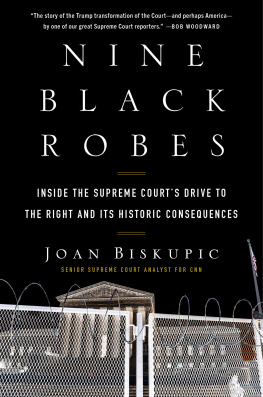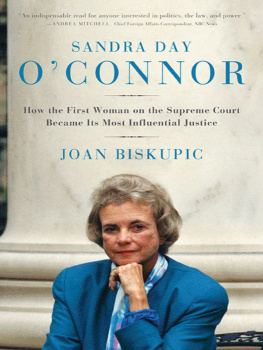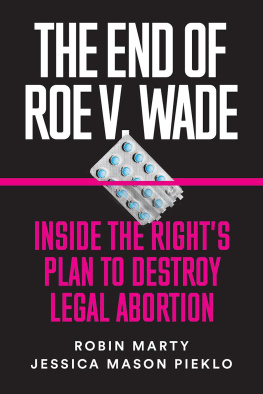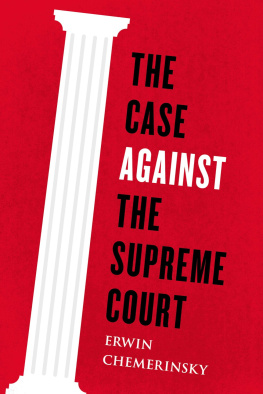Contents
Guide
For Clay and Elizabeth
No one should be confident that this majority is done with its work.
Dobbs v. Jackson Women's Health Organization, dissenting justices, June 24, 2022
This book is a group portrait of the Supreme Court during a historic period in American law influenced by the presidency of Donald Trump and its aftermath. The Court overturned nearly a half century of abortion rights, obliterated protections of the 1965 Voting Rights Act (VRA), curtailed government regulatory power, and blurred the separation of church and state. The transformed Court was decades in the making, but its character was solidified by the three appointees of former president Trump. From his campaign of 2016 into the early years of the Joe Biden administration, tensions within the Court spiraled. The justices maneuvered uneasily around each other. Two deaths marked this periodAntonin Scalias in 2016 and Ruth Bader Ginsburgs in 2020as did the COVID-19 pandemic.
I have relied on the records of cases, archives, and more than a hundred interviews with people on the Court and in its orbit, including a majority of the justices. This book also builds on my daily journalistic coverage of the Court and my four previous works on individual justices, including a biography of Scalia, the model for the Trump justices, and a biography of Chief Justice John Roberts, who recalibrated his leadership and his approach to the law with each addition to the bench.
Seven men and five women served in the years covered in this book: Roberts, appointed by George W. Bush in 2005; Anthony Kennedy, put on the bench by Ronald Reagan in 1988; Clarence Thomas, by George H. W. Bush in 1991; Ruth Bader Ginsburg, by Bill Clinton in 1993; Stephen Breyer, by Clinton in 1994; Samuel Alito, by George W. Bush in 2006; Sonia Sotomayor, by Barack Obama in 2009; Elena Kagan, by Obama in 2010; the three Trump appointees, Neil Gorsuch, 2017, Brett Kavanaugh, 2018, Amy Coney Barrett, 2020; and Ketanji Brown Jackson, selected by Biden in 2022 as the first Black woman justice, a groundbreaking appointment to a Court that has been, paradoxically, going backward.
Prologue
Unmasked
The lectern where the lawyers stood to argue their cases had been pushed back twenty feet from the Supreme Courts elevated bench. Dozens of wooden chairs that normally filled the front section of the courtroom were gone. The tableau on this November 1, 2021, morning was spare, as the coronavirus pandemic still raged and extra health precautions were in place. For the few spectators permitted to attend the suspenseful Texas abortion arguments, all wearing high-grade, tight-fitting masks and sitting well spaced on the red upholstered seats, the view of the nine justices was direct and unobstructed.
The Court had scheduled the morning hearing after letting a Texas abortion ban take effect in a midnight order on September 1. For two months, women in Americas second-most-populous state had been living without the right to abortion. The Supreme Court had guaranteed that right in its 1973 Roe v. Wade milestone and reaffirmed it many times, most definitively in 1992s Planned Parenthood of Southeastern Pennsylvania v. Casey. The Texas legislature had flouted those precedents and the Constitution and prohibited abortion after the first sign of fetal cardiac activity, roughly six weeks, a point when many women do not yet know they are pregnant and a point, too, at which fetal heart valves have not developed, making heartbeat law a misnomer.
Pregnant women who wanted an abortion were traveling to Oklahoma and other nearby states. Those without the money to leave Texas were panicking, forced to end their pregnancies on their ownmany using misoprostol and other oral medicationsor to carry an unwanted pregnancy to term. The Texas attorney general argued that the justices lacked jurisdiction even to hear the case because the legislature had written the law, shrewdly, in a way that let private individuals, not state officials, enforce it, thereby shielding officials from lawsuits. The statute granted a minimum of $10,000 in damages for each abortion successfully challenged. The threat of unlimited litigation and ruinous financial liability was forcing clinics to stop most abortions.
When the Supreme Court let the Texas law go forward on September 1, Chief Justice John Roberts dissented, joined by the senior liberal justice, Stephen Breyer, and Justices Sonia Sotomayor and Elena Kagan. The moment revealed a loss of control for the usually persuasive leader of the bench. Surely no proponent of abortion rights, Roberts was nonetheless astonished that a state would attempt to invalidate decisions tracing back nearly fifty years to Roe v. Wade. Only the Supreme Court itself had such power. The five conservatives who controlled that September 1 action sided with state officials, saying that the heartbeat bills challengers had failed to show that they were likely to succeed on the merits of the question or be irreparably harmed if the ban took effect during litigation. The applicants now before us have raised serious questions regarding the constitutionality of the Texas law at issue, the majority wrote in the unsigned order. But their application also presents complex and novel antecedent procedural questions on which they have not carried their burden. The majority brushed aside arguments about women awaiting immediate care, women who lacked the means to travel out of state, and women who, if delayed for even a few more weeks, would be affected by Texass separate deadlines for obtaining an abortion at all.
After that defeat, abortion clinics persisted with subsequent requests to the Court, and the U.S. Department of Justice entered the fight. Lawyers for President Joe Bidens administration filed a suit asserting that for half a century, this Court has held that a state may not prohibit any woman from making the ultimate decision to terminate her pregnancy before viabilitywith viability defined as the ability of the fetus to live outside the womb. The lawyers warned that if Texas was not stopped, any state could effectively nullify any constitutional decision of this Court, including those favored by conservativesfor example, allowing handguns in the home, or lifting restrictions on corporate spending in political campaigns.
The public commentary on the September 1 late-night opinion had been sufficiently harsh that less than two weeks later, Justice Amy Coney Barrett gave a speech in the Courts defense at the Seelbach Hilton in Louisville, Kentucky, at an event celebrating the University of Louisvilles McConnell Center, named for Senate Minority Leader Mitch McConnell, who a year earlier as majority leader had hastened Barretts confirmation to the Court. He introduced her at the September 13 event. My goal today is to convince you that this court is not comprised of a bunch of partisan hacks, Barrett told the audience.
The justices road show, unprecedented both in the swiftness with which it was carried out and in the degree to which it was roundly judged to have fallen flat, occupied the intervening weeks before oral arguments brought the debate over the Texas ban into the open. Chief Justice Roberts began the special November 1 hearing on a commemorative note, observing that Justice Clarence Thomass ceremonial investiture had taken place thirty years earlier to the day. What a curve the career of the seventy-three-year-old justice had taken: having joined the bench in 1991 after explosive Senate confirmation hearings, and having been consigned to the ideological fringe for more than twenty-five years, he was in the vanguard now, joined by the conservative appointees of former president Donald Trump.
Roberts also formally welcomed Elizabeth Prelogar, the solicitor general (SG) of the United States. A former assistant SG who had temporarily filled the top job and become familiar to the nine, Prelogar was making her debut argument with the full title after her Senate confirmation. Her filing to the justices, an effort to restore abortion rights in Texas, could not have been more strikingly inconsistent with what the justices had heard from the Trump administration on abortion. Trump had promised during his 2016 campaign to appoint pro-life judges to the Supreme Court who would strike down







